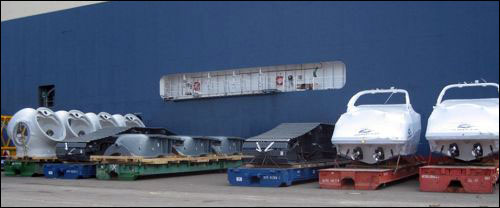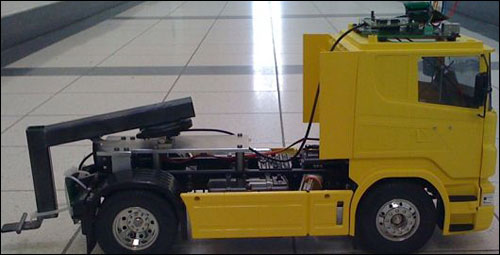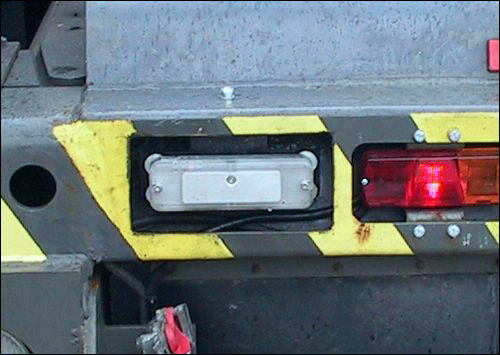BLG Logistics, a worldwide logistics firm, is implementing a pilot that employs EPC Gen 2 passive RFID tags and GPS technology to track the locations of rolltrailers at a seaport terminal it operates in Bremerhaven, Germany. The rolltrailers are loaded with heavy, odd-sized and extra-large equipment or machinery, such as locomotives, yachts or building material. Special tug vehicles equipped with heavy-duty engines are used to move the trailers onto and off of roll-on/roll-off (RORO) cargo ships, and then to tow them ashore to a storage yard or a loading area for overland transport of the trailers’ cargo.
Wolf Lampe, BLG Logistics’ director of innovative seaport technologies, and Anne Schweizer, a researcher at the Bremer Institute for Production and Logistics (BIBA), a scientific and engineering research institute at the University of Bremen, told attendees at last week’s RFID Journal LIVE! Europe 2010 conference that terminal personnel often spend excess time and burn fuel unnecessarily while attempting to locate a particular rolltrailer in the yard.
At any given time, some 1,000 rolltrailers circulate in the Bremerhaven terminal, and are stored in a yard 3 square kilometers (1.2 square miles) in size. When not loaded with cargo, the rolltrailers are stored one on top of another. Each year, BLG handles up to 60,000 rolltrailers that move into and out of the terminal aboard ships arriving from and departing to ports worldwide. The trailers are never utilized to carry equipment outside of the shipping terminal except on ships, since they are not approved for use on public streets.
Supported, in part, by a grant for innovative seaport technologies from the German Federal Ministry of Economics and Technology (BMWi), BLG Logistics began working with BIBA to jointly develop the yard-tracking system. The two partners, which launched the project in late 2008, are currently running tests on one reader and 10 RFID tags, with plans to commence a pilot in early 2011, once the proprietary software (which has been designed and defined) is fully developed.
From the project’s onset, BLG ruled out a solution based on bar-coded labels and scanners. “We wanted automatic identification,” Lampe explained, “because of the rugged industrial environment, and to reduce data-entry errors.”
The system that BLG and BIBA are testing combines RFID with GPS to record where the rolltrailers—which are owned by shipping companies—are stored within the yard. At present, all tracking is performed manually—that is, workers jot down each trailer’s ID number and yard location, using pen and paper.BIBA began by analyzing and documenting BLG’s rolltrailer processes. After studying those practices, it recommended a closed-loop tracking system that could later be expanded to an open-loop system—particularly given the interest that shipping companies have shown in the application.
“I’m sure that when the closed-loop system is proven, we’ll move to the open loop,” Lampe states. “The trailers are quite expensive, and shipping companies now have no reliable way to track them.”
For the pilot of the closed-loop system, BLG will attach removable EPC Gen 2 RFID tags to loaded trailers before they are taken off the RORO vessels. The tags must be removable, since they are the property of BLG and can not be shipped around the world with the trailer.
BLG and BIBA are now testing tags provided by Deister Electronic and Confidex. At this point, the partners report that they prefer Deister’s ultrahigh-frequency (UHF) UDL160 RFID tags because of their better read rates for this particular application. Each tag will cost less than €10 ($13.80) apiece, Schweizer says, not including its attachment to the trailer. BIBA is working to create a method for attaching the tags by magnet, so that they can be easily removed and re-used on different trailers—yet, the tags must still be rugged and sturdy enough to withstand potential jolts from other equipment.
For the pilot, tug vehicles will be fitted with a Deister UHF UDL100 forklift RFID reader, as well as a GPS receiver and an on-board computer and video screen for the driver. Data will be transmitted via the terminal’s existing WLAN infrastructure when vehicles come into range of a Wi-Fi access point. Once a vehicle is out of WLAN range, the information is stored locally in the onboard computer until a connection can be made.For the purposes of the pilot, BLG will tag rolltrailers on arriving ships, and then pull each rolltrailer off the vessel and into the yard. The worker whose job it is to inspect cargo for damage on the ship’s ramp will link a transponder to a particular rolltrailer, using a mobile RFID-enabled computer to input the unique ID number encoded to that transponder (such as 157302), along with the trailer number (such as NEVU 140 306-0). The system then knows which trailer is linked to which removable RFID tag. The employee will attach the transponder to the trailer, and the driver willapproach the trailer with the tug in order to attach it with the vehicle’s gooseneck arm. At that point, the tug vehicle’s interrogator will identify the trailer tag’s ID number. The driver will then receive an audio-visual signal from the onboard unit in the cab, indicating the identification was made.
A GPS reading will inform the system as to where the RFID readings were made, as well as where the vehicle has moved during its journey into the yard. The driver will receive a notice from the yard-management system on his or her computer screen, indicating where in the yard the rolltrailer is to be stored. After the driver arrives at that spot and parks the trailer, the trailer and the cab are decoupled. A motion detector will indicate that the trailer and tug vehicle have separated, and the last RFID read will take place. The system will then combine the information collected via RFID with the GPS and sensor data, and record the rolltrailer’s final storage spot within the yard, such as row X and spot 5.
When a driver is given the work order to retrieve the rolltrailer from the yard, its storage position data is sent to that individual’s computer screen. The driver then knows exactly where to go to pick up the trailer, instead of having to search for it. When he or she couples the rolltrailer with the tug vehicle, the reader interrogates that trailer’s RFID tag, and the system is updated regarding the trailer’s whereabouts as it is moved onto another ship.
Although the system tracks the movements of trailers, it is not designed to supervise workers. BIBA made efforts from the beginning of the project, Schweizer said, to explain the system to employees and listen to their concerns. “The system is not designed to monitor the movements of individual workers,” she stated.
The pilot is expected to last until October 2011, and BLG hopes to sell the system to shipping companies. The company further hopes to expand the application to take rolltrailer inventories using a mobile handheld reader, and to track all sorts of trailers in the yard, including smaller trailers for private boats.





